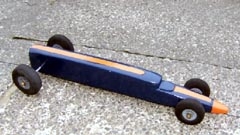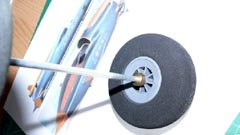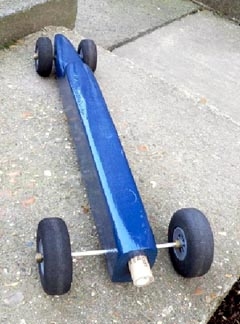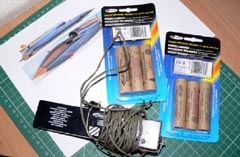
A mini rocket propelled BLOODHOUND was launched with crowds of onlookers at Southampton University March 7 for National Science and Engineering Week. About 600 people of all ages watched three launches during the day.
Easy to construct, these cars are a terrific source of material for school children to analyse and evaluate. This model weighs 200g and with a C engine can reach 100 mph along a 50m track. The track is a wire which passes through two wire staples underneath the body.
 Anyone attempting to launch a rocket car should write out an appropriate risk assessment and be sure to rope off the launch area. The model has been finished to resemble BLOODHOUND SSC.
Anyone attempting to launch a rocket car should write out an appropriate risk assessment and be sure to rope off the launch area. The model has been finished to resemble BLOODHOUND SSC.
 Model aircraft wheels and a balsa wood body with a hole drilled at the back to take the rocket motors. Brass collets have been used to fix the wheels to the solid axles which have been passed through holes in the body.
Model aircraft wheels and a balsa wood body with a hole drilled at the back to take the rocket motors. Brass collets have been used to fix the wheels to the solid axles which have been passed through holes in the body.
 Two brass colletts are needed for each wheel. Make sure that the grub screws are tight after each run.
Two brass colletts are needed for each wheel. Make sure that the grub screws are tight after each run.
 The hole for the engine must be drilled as accurately as possible. Ensure that it is above the centre of gravity and that the hole for the rear axle will pass underneath
The hole for the engine must be drilled as accurately as possible. Ensure that it is above the centre of gravity and that the hole for the rear axle will pass underneath
 In this picture the rocket engine is seen protruding form the rear of the body. It must be a loose fit so that the final charge which would normally expel the parachute, expels the spent engine instead. Take car not to touch the ejected engine as it will be extremely hot.
In this picture the rocket engine is seen protruding form the rear of the body. It must be a loose fit so that the final charge which would normally expel the parachute, expels the spent engine instead. Take car not to touch the ejected engine as it will be extremely hot.
 Estes engines are very reliable if kept dry. The starter unit involves one operator to check systems and hold the ready key in while another to presses the launch button.
Estes engines are very reliable if kept dry. The starter unit involves one operator to check systems and hold the ready key in while another to presses the launch button.
B and C size engines will fit the same size hole. A C size engine will provide 6 N of thrust for 1.5 seconds.
An acceleration of 30m/s/s suggests a top speed of 45 m/s (101 mph) after 1.5 seconds and about 34 meters. Of course air resistance and friction will reduce the top speed but children could carry investigations to measure the maximum speed reached with different mass vehicles.
It is interesting to consider how this scales up to the real vehicle. A linear ratio of 20:1 suggests that the mass ratio should be 8000:1, so that the models mass would be something less than 1 kg!

